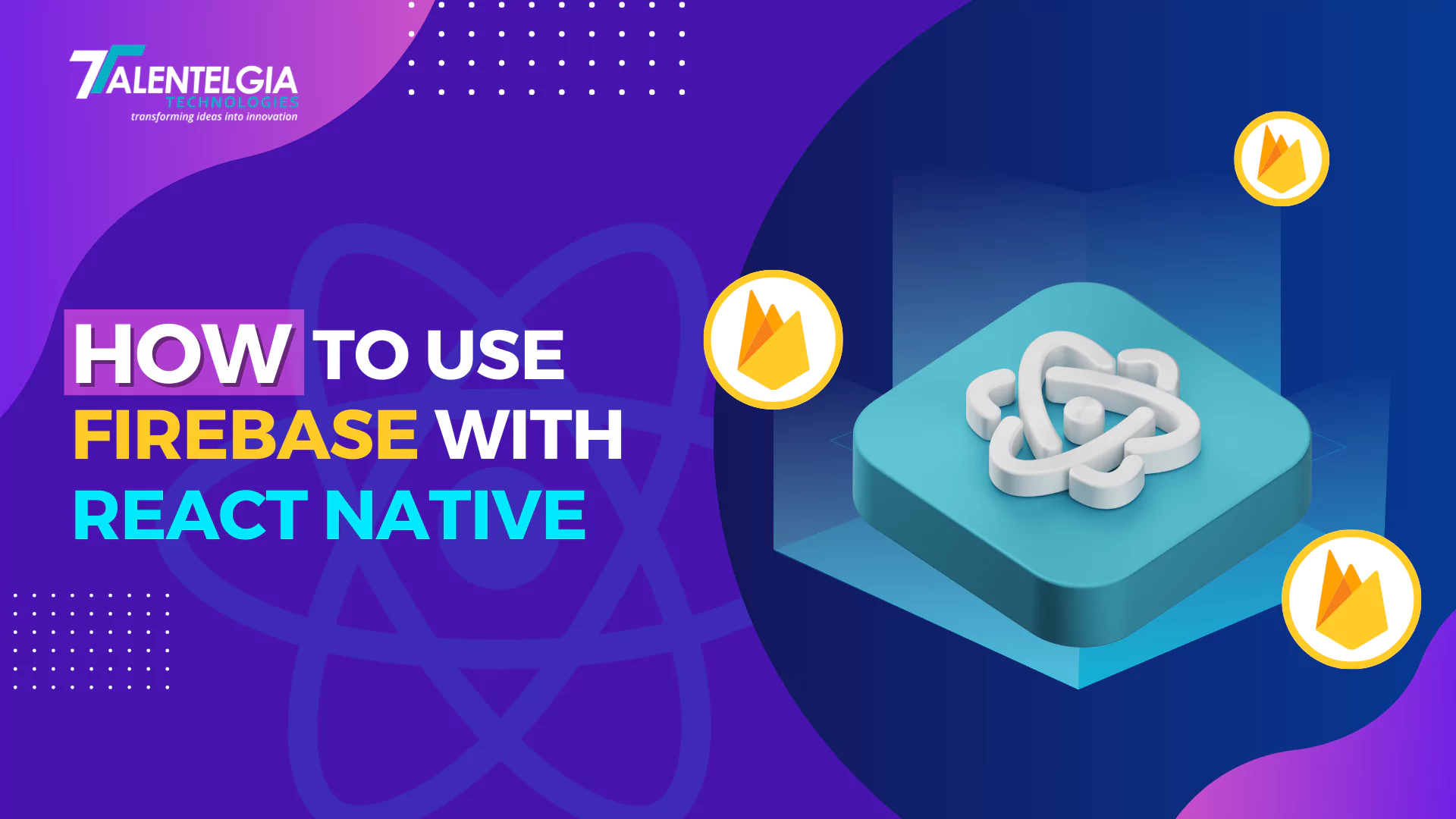Firebase is a powerful backend-as-a-service (BaaS) platform created by Google. It provides a wide range of tools for the easy development, management, and growth of web and mobile apps. Known for its real-time data handling and extensive features including analytics, crash reporting, and machine learning, Firebase significantly speeds up development processes and efficiently manages application data. Paired with React Native, Firebase becomes an invaluable asset for developers attempting to create efficient cross-platform applications.
with Expert Firebase
& React Development. With over a decade of experience,
Talentelgia excels in delivering
cutting-edge development services.

This tutorial provides an in-depth blog on integrating Firebase within a React Native app.
Benefits of Using Firebase with React Native
Integrating Firebase with React Native brings forth a multitude of benefits that significantly bolster both app development and operational performance. Below is a thorough look into the advantages:
Real-time Data Synchronization
Firebase is renowned for its real-time database capability which promotes uninterrupted data flow across all platforms and devices. Every alteration within the database is sent instantaneously to all linked clients. This feature is indispensable for apps that rely on real-time information updates such as chat applications or live event tracking. The instantaneous data reflection not only cultivates an enhanced user experience by making the latest information readily available but also maintains uniformity of data across all devices, eliminating the need for manual updates.
Authentication
The robust, secure authentication infrastructure provided by Firebase drastically eases the management of user identities. By supporting a multitude of authentication methods including social logins (Google, Facebook, Twitter) and traditional e-mail sign-ups, Firebase simplifies complex authentication operations. Designed for both robustness and ease of implementation, Firebase Authentication handles routine tasks like user management, password resets, and email confirmations efficiently, freeing developers from potential security concerns and complex setup procedures.
Cloud Functions
Firebase Cloud Functions serve as a nimble backend solution where you can execute code in response to events initiated by Firebase services or HTTP requests. This serverless computing enables automated responses to changes in Auth, Firestore, or the Realtime Database, facilitating tasks such as notifications, data updates, or external integrations without managing a private server. This capacity allows developers to concentrate more on the front end while Firebase smoothly operates the backend operations.
Analytics and Monitoring
With Firebase, developers gain access to detailed analytics and monitoring tools that are crucial for tracking user engagement and app responsiveness. Firebase Analytics delves into user interaction patterns, providing essential insights that help in refining app functionalities and interfaces. Additionally, Firebase can be linked with platforms like Google Ads to improve marketing by allowing for precise targeting of users. Firebase Performance Monitoring helps identify and remedy app performance issues, ensuring the app operates smoothly without any delays or interruptions.
By merging these functionalities with the cross-platform adaptability offered by React Native, developers achieve heightened efficiency and reduced development timelines. React Native facilitates the maintenance of a singular codebase for both iOS and Android platforms, slashing development resources and costs. When used alongside Firebase, it amplifies productivity by streamlining backend tasks such as data sync, user authentication, and server handling.
As for scalability, Firebase automatically adjusts to an app’s growth demands, accommodating expanding user bases smoothly. This adaptive nature, combined with robust real-time databases and performance analytics, ensures that the application performs efficiently and remains proactive, thereby boosting user satisfaction and engagement.
Setting Up Your Firebase Project with React Native
Step 1: Create a New Firebase Project
- Navigate to the Firebase Console.
- Select “Add project” and proceed with the provided setup instruction steps.
Step 2: Adding Firebase to Your Android App
Premier Firebase &
React Development With over a decade of experience,
Talentelgia excels in providing
top-notch services.

- Within your Firebase project, choose “Add app” and opt for the Android platform.
- Follow all setup steps carefully, input your app specifics, and ensure accuracy.
- Download the google-services.json file and implement it in your app’s Android/app directory.
Configuring React Native App
Step 1: Installing Dependencies for Firebase
npm install @react-native-firebase/appnpm install @react-native-firebase/authnpm install @react-native-firebase/firestore
# Add other necessary dependenciesStep 2: Setting Up Firebase with React Native
//Initialize Firebase in your app’s entry point (usually index.js)
JavaScript
import {AppRegistry} from 'react-native';
import {App} from './App'; // Your main app component
import {name as appName} from './app.json';
import {firebase} from '@react-native-firebase/app';
firebase.initializeApp({
// Your Firebase config
});
AppRegistry.registerComponent(appName, () => App);Integrating Firebase Authentication
Registration with Firebase Auth
JavaScript
import {firebase} from '@react-native-firebase/auth';
const registerUser = async (email, password) => {
try {
await firebase.auth().createUserWithEmailAndPassword(email, password);
// Handle success
}
catch(error){
// Handle error
}
};Login with Firebase Auth
JavaScript
const loginUser = async (email, password) => {
try {
await firebase.auth().signInWithEmailAndPassword(email, password);
// Handle success
}
catch(error){
// Handle error
}
};Conclusion
Using Firebase with React Native makes backend development easier and improves the performance and growth potential of apps. This blog has given you the basic knowledge needed to use Firebase in your React Native projects effectively. To get a better understanding and discover more about the additional features and tools that Firebase offers, it’s recommended to read through Firebase’s comprehensive documentation. By doing so, you can improve and fine-tune your mobile apps, making them more robust and easier to use.


 Healthcare App Development Services
Healthcare App Development Services
 Real Estate Web Development Services
Real Estate Web Development Services
 E-Commerce App Development Services
E-Commerce App Development Services E-Commerce Web Development Services
E-Commerce Web Development Services Blockchain E-commerce Development Company
Blockchain E-commerce Development Company
 Fintech App Development Services
Fintech App Development Services Fintech Web Development
Fintech Web Development Blockchain Fintech Development Company
Blockchain Fintech Development Company
 E-Learning App Development Services
E-Learning App Development Services
 Restaurant App Development Company
Restaurant App Development Company
 Mobile Game Development Company
Mobile Game Development Company
 Travel App Development Company
Travel App Development Company
 Automotive Web Design
Automotive Web Design
 AI Traffic Management System
AI Traffic Management System
 AI Inventory Management Software
AI Inventory Management Software
 AI Software Development
AI Software Development  AI Development Company
AI Development Company  AI App Development Services
AI App Development Services  ChatGPT integration services
ChatGPT integration services  AI Integration Services
AI Integration Services  Generative AI Development Services
Generative AI Development Services  Natural Language Processing Company
Natural Language Processing Company Machine Learning Development
Machine Learning Development  Machine learning consulting services
Machine learning consulting services  Blockchain Development
Blockchain Development  Blockchain Software Development
Blockchain Software Development  Smart Contract Development Company
Smart Contract Development Company  NFT Marketplace Development Services
NFT Marketplace Development Services  Asset Tokenization Company
Asset Tokenization Company DeFi Wallet Development Company
DeFi Wallet Development Company Mobile App Development
Mobile App Development  IOS App Development
IOS App Development  Android App Development
Android App Development  Cross-Platform App Development
Cross-Platform App Development  Augmented Reality (AR) App Development
Augmented Reality (AR) App Development  Virtual Reality (VR) App Development
Virtual Reality (VR) App Development  Web App Development
Web App Development  SaaS App Development
SaaS App Development Flutter
Flutter  React Native
React Native  Swift (IOS)
Swift (IOS)  Kotlin (Android)
Kotlin (Android)  Mean Stack Development
Mean Stack Development  AngularJS Development
AngularJS Development  MongoDB Development
MongoDB Development  Nodejs Development
Nodejs Development  Database Development
Database Development Ruby on Rails Development
Ruby on Rails Development Expressjs Development
Expressjs Development  Full Stack Development
Full Stack Development  Web Development Services
Web Development Services  Laravel Development
Laravel Development  LAMP Development
LAMP Development  Custom PHP Development
Custom PHP Development  .Net Development
.Net Development  User Experience Design Services
User Experience Design Services  User Interface Design Services
User Interface Design Services  Automated Testing
Automated Testing  Manual Testing
Manual Testing  Digital Marketing Services
Digital Marketing Services 
 Ride-Sharing And Taxi Services
Ride-Sharing And Taxi Services Food Delivery Services
Food Delivery Services Grocery Delivery Services
Grocery Delivery Services Transportation And Logistics
Transportation And Logistics Car Wash App
Car Wash App Home Services App
Home Services App ERP Development Services
ERP Development Services CMS Development Services
CMS Development Services LMS Development
LMS Development CRM Development
CRM Development DevOps Development Services
DevOps Development Services AI Business Solutions
AI Business Solutions AI Cloud Solutions
AI Cloud Solutions AI Chatbot Development
AI Chatbot Development API Development
API Development Blockchain Product Development
Blockchain Product Development Cryptocurrency Wallet Development
Cryptocurrency Wallet Development About Talentelgia
About Talentelgia  Our Team
Our Team  Our Culture
Our Culture 
 Healthcare App Development Services
Healthcare App Development Services Real Estate Web Development Services
Real Estate Web Development Services E-Commerce App Development Services
E-Commerce App Development Services E-Commerce Web Development Services
E-Commerce Web Development Services Blockchain E-commerce
Development Company
Blockchain E-commerce
Development Company Fintech App Development Services
Fintech App Development Services Finance Web Development
Finance Web Development Blockchain Fintech
Development Company
Blockchain Fintech
Development Company E-Learning App Development Services
E-Learning App Development Services Restaurant App Development Company
Restaurant App Development Company Mobile Game Development Company
Mobile Game Development Company Travel App Development Company
Travel App Development Company Automotive Web Design
Automotive Web Design AI Traffic Management System
AI Traffic Management System AI Inventory Management Software
AI Inventory Management Software AI Software Development
AI Software Development AI Development Company
AI Development Company ChatGPT integration services
ChatGPT integration services AI Integration Services
AI Integration Services Machine Learning Development
Machine Learning Development Machine learning consulting services
Machine learning consulting services Blockchain Development
Blockchain Development Blockchain Software Development
Blockchain Software Development Smart contract development company
Smart contract development company NFT marketplace development services
NFT marketplace development services IOS App Development
IOS App Development Android App Development
Android App Development Cross-Platform App Development
Cross-Platform App Development Augmented Reality (AR) App
Development
Augmented Reality (AR) App
Development Virtual Reality (VR) App Development
Virtual Reality (VR) App Development Web App Development
Web App Development Flutter
Flutter React
Native
React
Native Swift
(IOS)
Swift
(IOS) Kotlin (Android)
Kotlin (Android) MEAN Stack Development
MEAN Stack Development AngularJS Development
AngularJS Development MongoDB Development
MongoDB Development Nodejs Development
Nodejs Development Database development services
Database development services Ruby on Rails Development services
Ruby on Rails Development services Expressjs Development
Expressjs Development Full Stack Development
Full Stack Development Web Development Services
Web Development Services Laravel Development
Laravel Development LAMP
Development
LAMP
Development Custom PHP Development
Custom PHP Development User Experience Design Services
User Experience Design Services User Interface Design Services
User Interface Design Services Automated Testing
Automated Testing Manual
Testing
Manual
Testing About Talentelgia
About Talentelgia Our Team
Our Team Our Culture
Our Culture

















 Write us on:
Write us on:  Business queries:
Business queries:  HR:
HR: 




